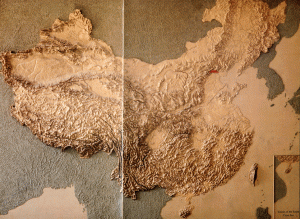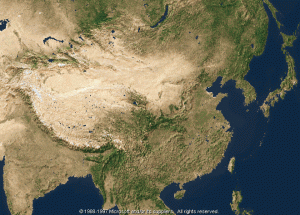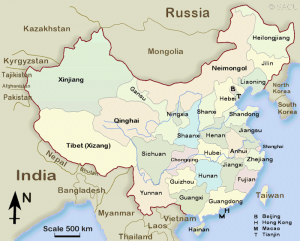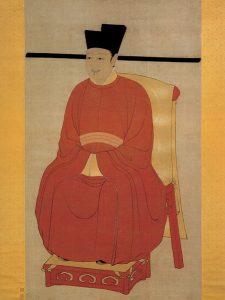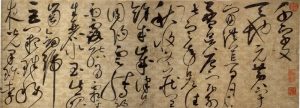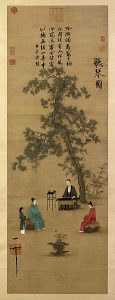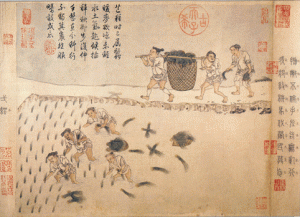Shifting South
I. The Jurchen/Jin State (1115–1234)
- History—Manchuria . . . “cooked” vs. “uncooked”
- Jin administration—founded 1115 . . .Wanyan Aguda (r. 1113–1123)
II. The Southern Song (1127–1276)
- The Fall of Kaifeng (1127)—Emperor Huizong (r. 1100–26)
- The Southern court at Hangzhou—Emperor Gaozong (r. 1129–62) . . . peace treaty (annual payment of 300,000 ounces of silver, 1 million strings of coins, and 300,000 bolts of silk + one-time payment of 180 annual payments . . . Jurchen ruler as elder uncle)
- The Case of Yue Fei (1103–42)—treaty of 1141 (return of the bodies)—Qin Gui (1090–1155) . . . “Full River Red“
III. Economic and Social Change
- Demographic change—population expansion . . . southward shift
- Agricultural developments—e.g., quick-ripening rice
- Economic expansion—credits/paper money . . . commercialization (wine, charcoal, paper, textiles, silk, sugar cane, etc.) . . . Qingming scroll (Hansen’s intro) . . . material culture
- Social change—the literati . . . civil service examinations
Rethinking the Way
I. Background
- Confucius (Kongzi 孔子, ca. 551–479 BCE) . . . Spring and Autumn period (722–481 B.C.E.) . . . teacher/philosopher . . . transmitter of the Way (Dao 道)
- “Confucianism”—Analects (Lun yu 論語) . . . gentleman/noble man/exemplary person (jun zi 君子) . . . human-ness (ren 仁) . . . rites/rituals (li 禮)
- Revival of Confucianism—Buddhism . . . Han Yu (768–824) . . . “Ancient Style”
II. Song Confucianism
- Politics—Fan Zhongyan . . . Wang Anshi . . . Sima Guang
- Metaphysics—Zhou Dunyi (1017–1073) . . . Cheng Hao (1032–1085) . . . Cheng Yi (1033–1107) . . . Great Ultimate . . . correlative cosmology
III. Zhu Xi (1130–1200)
- Intellectual Synthesizer
- li 理 (principle; coherence) and qi 氣 (vital energy; material force) . . . Four Books (Great Learning, Doctrine of the Mean, Analects, Mencius)
IV. Local Society
Discussion
- What social background did Yuan Cai [Yüan Ts'ai] (ca. 1140–95) come from?
- What were Yuan Cai's major concerns? For whom did Yuan write Precepts for Social Life?
- What can Yuan's text tell us about the social conditions of the Southern Song?
- Why did a text such as Yuan's appear in twelfth-century China?
Maps
External links to Maps:
Physical Map
Source: National Museum of Chinese History, ed., A Journey into China's Antiquity, vol. 1 (Beijing: Morning Glory Publishers, 1997), pp. 8–9.
Physical Map by Satellite
Administrative Map
Source: SACU
Images
References
- Chaffee, John W. The Thorny Gates of Learning in Sung China: A Social History of Examinations. Cambridge: Cambridge University Press, 1985.
- Ebrey, Patricia Buckley. The Inner Quarters: Marriage and the Lives of Chinese Women in the Sung Period. Berkeley and Los Angeles: University of California Press, 1993.
- Gardner, Daniel K., trans. Learning to be a Sage: Selections from the Conversations of Master Chu, Arranged Topically. Berkeley and Los Angeles: University of California Press, 1990.
- Gernet, Jacques. Daily life in China, on the Eve of the Mongol Invasion, 1250–1276. Stanford: Stanford University Press, 1962.
- Hymes, Robert P. Statesmen and Gentlemen: The Elite of Fu-chou, Chiang-hsi, in Northern and Southern Sung. Cambridge: Cambridge University Press, 1987.
- Liu, James T. C. China Turning Inward: Intellectual-Political Changes in the Early Twelfth Century. Cambridge, Mass.: Council on East Asian Studies, Harvard University, 1988.

